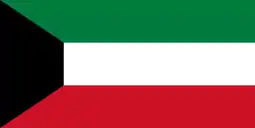Abdullah Al-Salim Al-Sabah
Sheikh Abdullah Al-Salim Al-Sabah (1895 – 24 November 1965, Arabic: الشيخ عبد الله الثالث السالم الصباح) was the ruler of Kuwait and commander-in-chief of Kuwait Military Forces from 29 January 1950 to his death in 1965; after the country gained its independence on 19 June 1961, he was titled Emir of Kuwait.
| Abdullah Al-Salim Al-Sabah | |
|---|---|
 | |
| Emir of Kuwait | |
| Reign | 29 January 1950 – 24 November 1965 |
| Coronation | 25 February 1950 |
| Predecessor | Ahmad Al-Jaber Al-Sabah |
| Successor | Sabah III Al-Salim Al-Sabah |
| Born | 1895 Sheikhdom of Kuwait |
| Died | 24 November 1965 (aged 69–70) |
| Father | Salim Al-Mubarak Al-Sabah |
| Mother | Sheikha Mariam bint Jarrah Al-Sabah |
Biography
Abdullah was the eldest son of Salim Al-Mubarak Al-Sabah. He was the minister of finance from 1939 to 1940.[1] He took power after the death of his cousin Ahmad Al-Jaber Al-Sabah and also ruled as regent upon the death of his father until the election of Sheikh Ahmad. The anniversary of his coronation, 25 February, serves as Kuwait's national day.[2]
Unlike his predecessors, Abdullah was more pro-Arab than pro-British. He effectively ended the British "protectorate" status of Kuwait by signing a treaty with the British on 19 June 1961. He is regarded as the founder of modern Kuwait. He introduced the Constitution of Kuwait in 1962, followed by the Parliament in 1963. He was much more committed to constitutionalism and parliamentary democracy in contrast to next rulers.[3]
Death
Abdullah Al-Salim died on November 24th 1965 after suffering from a heart attack during the opening session of the National Assembly.
Honours and awards
National
 Sovereign Grand Master of the Order of National Defense
Sovereign Grand Master of the Order of National Defense.gif) Sovereign Grand Master of the Military Duty Order
Sovereign Grand Master of the Military Duty Order
References
- "وزارة المالية - دولة الكويت". www.mof.gov.kw.
- "National and liberation days". Kuwait Times. 26 February 2015. Retrieved 23 February 2018.
- Paul Salem (June 2007). "Kuwait: Politics in a Participatory Emirate" (PDF). Carnegie Endowment for International Peace (3): 4.

